It looks like you're using an Ad Blocker.
Please white-list or disable AboveTopSecret.com in your ad-blocking tool.
Thank you.
Some features of ATS will be disabled while you continue to use an ad-blocker.
share:
Congratulations!
This topic and thread has been chosen to be discussed by the ATS LIVE crew this Saturday night between 6-9pm pst (9-12 est), as part of this weeks exciting "Turbo Topics" segment.


We are running 256kbps through the ATS Player but we now run a 32kbps stream for those of you with slower connections and there are also options to listen via other players on our relay site at Illustrial Website. You can also connect to the low bandwidth stream by clicking here to listen to the ATSLive Radio Show on ShoutCast
For more information and past shows, be sure to check out the ATSLive Show Threads Here.
Hope you'll listen in to the show!
Johnny
reply to post by Turkenstein
No I see it. Originally I was looking at a cropped picture from the original post thinking it was different than the whole mosaic. I can't help but think we are looking at two seperate artists here. Maybe one started and subsequently got eaten by a Mastadon or something and finished by a less skilled artist.
Aside from several obvious mistakes on the left side and the uncomfortable and not so fluid strokes to the right side of all Rhinos where shadowing techniques is wonderful. In fact I also couldn't help but notice a wolf and owl in the shadow. But I don't think either are indigenous so I didn't spend a lot of time on that.
But now look on the left side. Not only do the bears/lions appear of lesser quality, from the pics it looked like the artist struggled in the middle with the mirage of animals. I would think if it is the same artist then he isn't nearly as comfortable drawing bears as he is Rhinos. The fact we struggle to differentiate whether its a bear or lion is telling in itself no?
No I see it. Originally I was looking at a cropped picture from the original post thinking it was different than the whole mosaic. I can't help but think we are looking at two seperate artists here. Maybe one started and subsequently got eaten by a Mastadon or something and finished by a less skilled artist.
Aside from several obvious mistakes on the left side and the uncomfortable and not so fluid strokes to the right side of all Rhinos where shadowing techniques is wonderful. In fact I also couldn't help but notice a wolf and owl in the shadow. But I don't think either are indigenous so I didn't spend a lot of time on that.
But now look on the left side. Not only do the bears/lions appear of lesser quality, from the pics it looked like the artist struggled in the middle with the mirage of animals. I would think if it is the same artist then he isn't nearly as comfortable drawing bears as he is Rhinos. The fact we struggle to differentiate whether its a bear or lion is telling in itself no?
reply to post by DENBY
I think I see what you're trying to point out.. it's very subtle.
As for the cat and Egypt connection... did you read the bit I wrote about the Sphinx??
I think I see what you're trying to point out.. it's very subtle.
As for the cat and Egypt connection... did you read the bit I wrote about the Sphinx??
As an artist I simply wouldn't have a section so intricate like we do with the pile of rhinos and not have similar sharing techniques on the other
half. Also the rhino facing the opposite direction doesn't appear to be of similar quality or style as all the rhinos on the right facing left in my
opinion.
reply to post by frenzy4444
I did consider that.. I know it Ra, but it seems many others know it as Horus..
I even checked up on it a bit..
en.wikipedia.org...
Notice the bit about being multi layered... So are the cave paintings..
It still baffles me as to how and why they made the crater specific in the map.. and why does the crater have a marking very similar to the eye of Horus/Ra.. Was this marking naturaly occuring when the crater formed or was it man made??
If it was mane made, how the heck were they able to see the crater as an eye in the first place???
Flight?
I had trouble deciding which to use seeing as they appear to be linked..
en.wikipedia.org...
see the confusion?
I had originally gone with Ra, but changed.. saddly, I wish I had stuck with Ra due to one item I found in the paintings but that item cannot yet be determined to be what I think it might be..
I did consider that.. I know it Ra, but it seems many others know it as Horus..
I even checked up on it a bit..
Horus is one of the oldest and most significant deities in ancient Egyptian religion, who was worshipped from at least the late Predynastic period through to Greco-Roman times. Different forms of Horus are recorded in history, and these are treated as distinct gods by Egyptologists.[1] These various forms may possibly be different perceptions of the same multi-layered deity in which certain attributes or syncretic relationships are emphasized, not necessarily in opposition but complementary to one another, consistent with how the Ancient Egyptians viewed the multiple facets of reality.[2] He was most often depicted as a falcon, most likely a lanner or peregrine, or as a man with a falcon head.[3]
The earliest recorded form of Horus is the patron deity of Nekhen in Upper Egypt, who is the first known national god, specifically related to the king who in time came to be regarded as a manifestation of Horus in life and Osiris in death.[1] The most commonly encountered family relationship describes Horus as the son of Isis and Osiris but in another tradition Hathor is regarded as his mother and sometimes as his wife.[1] Horus served many functions in the Egyptian pantheon, most notably being the god of the sun, war and protection.
en.wikipedia.org...
Notice the bit about being multi layered... So are the cave paintings..
It still baffles me as to how and why they made the crater specific in the map.. and why does the crater have a marking very similar to the eye of Horus/Ra.. Was this marking naturaly occuring when the crater formed or was it man made??
If it was mane made, how the heck were they able to see the crater as an eye in the first place???
Flight?
I had trouble deciding which to use seeing as they appear to be linked..
The Eye of Horus is an ancient Egyptian symbol of protection and royal power from deities, in this case from Horus or Ra.
en.wikipedia.org...
en.wikipedia.org...
In later Egyptian dynastic times, Ra was merged with the god Horus, as Re-Horakhty ("Ra, who is Horus of the Two Horizons"). He was believed to rule in all parts of the created world the sky, the earth, and the underworld.[3] He was associated with the falcon or hawk. When in the New Kingdom the god Amun rose to prominence he was fused with Ra as Amun-Ra. During the Amarna Period, Akhenaten suppressed the cult of Ra in favour of another solar deity, the Aten, the deified solar disc, but after the death of Akhenaten the cult of Ra was restored.
see the confusion?
I had originally gone with Ra, but changed.. saddly, I wish I had stuck with Ra due to one item I found in the paintings but that item cannot yet be determined to be what I think it might be..
reply to post by Extralien
Perhaps my being Italian drew my eyes to what would be a very subtle image of Italy.
Maybe it is pictured in a more abstract manner by design.
Regarding the Sphinx yes.
I have always seen the Sphinx as one of the most mysterious & intriguing things ever.
Origins? Age? Significance? (Or Not?) ...
The Sphinx is a topic of discussion unto itself.
As I have said there is much to be considered.
Perhaps my being Italian drew my eyes to what would be a very subtle image of Italy.
Maybe it is pictured in a more abstract manner by design.
Regarding the Sphinx yes.
I have always seen the Sphinx as one of the most mysterious & intriguing things ever.
Origins? Age? Significance? (Or Not?) ...
The Sphinx is a topic of discussion unto itself.
As I have said there is much to be considered.
reply to post by masta12d
Don't forget they had limited light to work with. unfortunately we may never know exactly how little light they, or how much, seeing as the originalmain entrance is sealed up.. It might have looked a lot different back then..
As for other creatures.. Thibk I've gone and found a gorilla.. I at first thought it was Human but the down turned mouth was throwing me off.
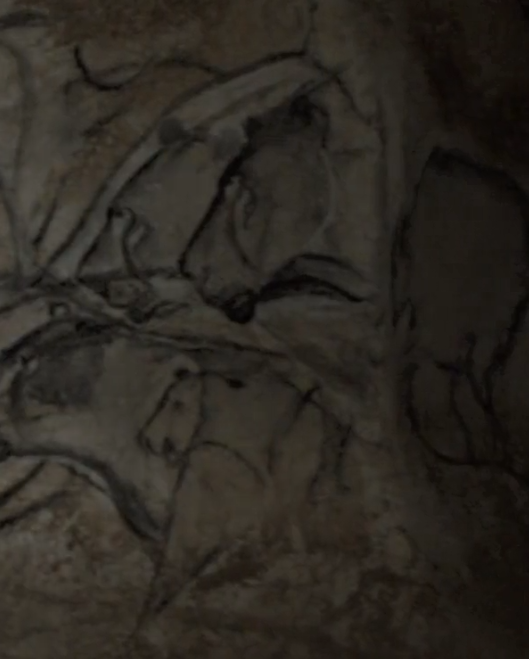
and please excuse my not sosteady artistic style
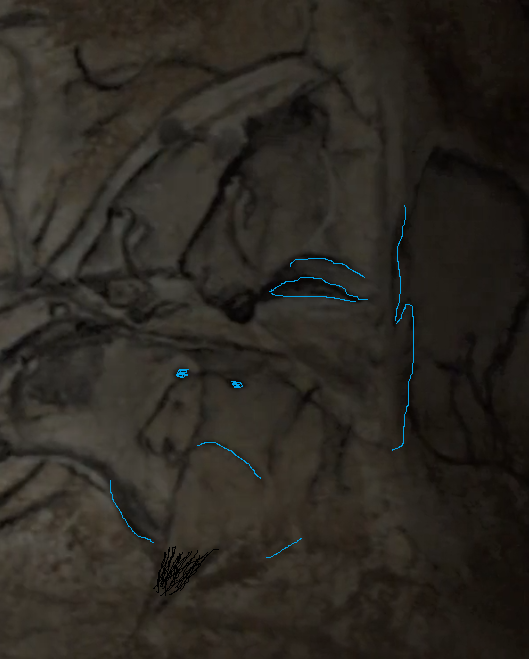
i've noticed that the best way to see the 'face' (whatever it belongs to) is to find the eye, then the pupil and look directly at that, then the rest of the face will fall into place in your peripheral vision.
Don't forget they had limited light to work with. unfortunately we may never know exactly how little light they, or how much, seeing as the originalmain entrance is sealed up.. It might have looked a lot different back then..
As for other creatures.. Thibk I've gone and found a gorilla.. I at first thought it was Human but the down turned mouth was throwing me off.

and please excuse my not sosteady artistic style

i've noticed that the best way to see the 'face' (whatever it belongs to) is to find the eye, then the pupil and look directly at that, then the rest of the face will fall into place in your peripheral vision.
edit on 27-12-2012 by Extralien because: (no reason given)
reply to post by DENBY
Yes I think it has been done like on purpose.
It's such an obvious shape.. very clever people..
As for the Sphinx, i believe I included a link to Dr. Schoch and his work regarding the age of the Sphinx..
posting again here.
www.robertschoch.com...
Yes I think it has been done like on purpose.
It's such an obvious shape.. very clever people..
As for the Sphinx, i believe I included a link to Dr. Schoch and his work regarding the age of the Sphinx..
posting again here.
www.robertschoch.com...
Well done. Very well put together. I got pretty far through, but I can't see any pics your using for evidence. I will get on a PC and s+f it, and have
a good look at the pics. Thanks for the read
Posted Via ATS Mobile: m.abovetopsecret.com
Then there is the Eye of Horus of 1st Eden above Egypt in the times of the two lands,
www.dalamatiacity.com...
www.dalamatiacity.com...
This image of what I call the half fish man, has been cleaned up a bit by JohnnyAnonymous
Big thanks to him for helping out a bit..
I hope the left leg and left arm are more visible.. If you look closely you may even spot what could possibly be a tail curling around the rear buttock.
Are we sure this is not telling us that we crawled out of the waters onto dry land to evolve?
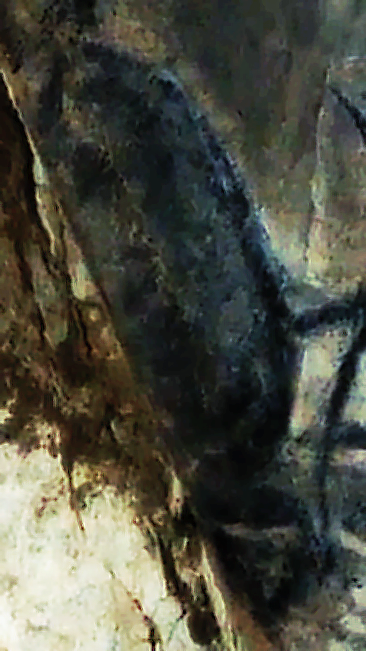
Am digging out a couple of other pictures that kinda hint at something, but they don't give a definite answer.. Justlike everything else we can see...
It's a lot like this picture that was posted on FB, clever use of colours and imagery, yet this is so defined we can work it out a lot faster, but this is a good comparison for what we're dealing with in the caves.
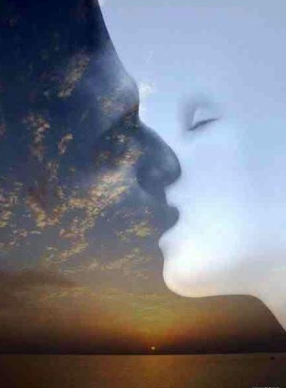
Big thanks to him for helping out a bit..
I hope the left leg and left arm are more visible.. If you look closely you may even spot what could possibly be a tail curling around the rear buttock.
Are we sure this is not telling us that we crawled out of the waters onto dry land to evolve?

Am digging out a couple of other pictures that kinda hint at something, but they don't give a definite answer.. Justlike everything else we can see...
It's a lot like this picture that was posted on FB, clever use of colours and imagery, yet this is so defined we can work it out a lot faster, but this is a good comparison for what we're dealing with in the caves.

Domestication
There are two pictures that stand out..well it all stands out but you know what I mean..
One picture is on its own..
It appears to be a camel.. with a difference..
Is it wearing a harness ready to pull stuff?
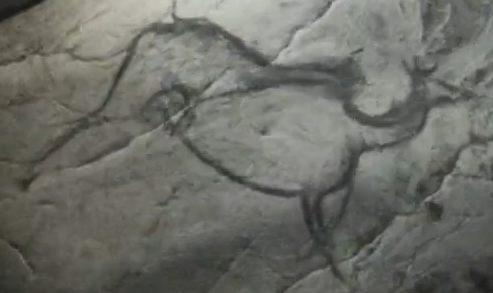
And this horse.. It is bleeding at its mouth.. the bleeding seems to have been caused by a set of reins that have been fitted..
From what I remember, horses do bleed in the mouth if the bit is incorrect or you try any other method of fitting the reins without a bit.. so is that the case here?
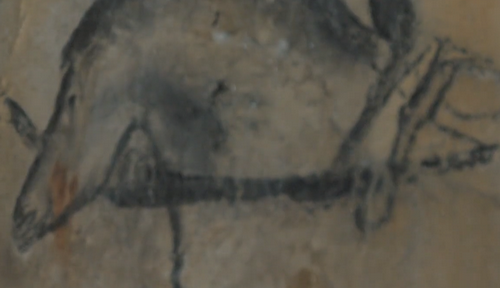
If it is bleeding caused by reins then we might have to re-write wikipedia.. and..um.. everything else..
en.wikipedia.org...
notice that getting an exact date is very hard to do..
We see them talking about the seperation of species by breeding different horses together which was controlled by humans..
is that why we see these four horses heads lined up.. they're a selection.. a set of different types for different purposess.
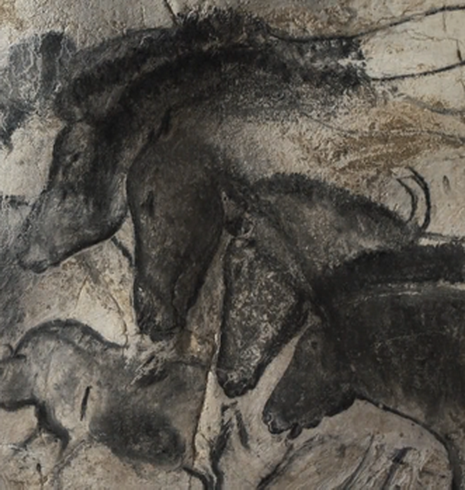
Either way, it may prove to be impossible to gve an exact date as to when we utilised the horse rather than just eating it.
en.wikipedia.org...
There are two pictures that stand out..well it all stands out but you know what I mean..
One picture is on its own..
It appears to be a camel.. with a difference..
Is it wearing a harness ready to pull stuff?

And this horse.. It is bleeding at its mouth.. the bleeding seems to have been caused by a set of reins that have been fitted..
From what I remember, horses do bleed in the mouth if the bit is incorrect or you try any other method of fitting the reins without a bit.. so is that the case here?

If it is bleeding caused by reins then we might have to re-write wikipedia.. and..um.. everything else..
A number of hypotheses exist on many of the key issues regarding the domestication of the horse. Although horses appeared in Paleolithic cave art as early as 30,000 BCE, these were truly wild horses and were probably hunted for meat. How and when horses became domesticated is disputed. The clearest evidence of early use of the horse as a means of transport is from chariot burials dated c. 2000 BCE. However, an increasing amount of evidence supports the hypothesis that horses were domesticated in the Eurasian Steppes (Dereivka centered in Ukraine) approximately 4000-3500 BCE.[1][2][3] Recent discoveries on Botai culture suggest that Botai culture settlements in the Akmola Province of Kazakhstan are the location of the earliest domestication of the horse.[4]
The date of the domestication of the horse depends to some degree upon the definition of "domestication". Some zoologists define "domestication" as human control over breeding, which can be detected in ancient skeletal samples by changes in the size and variability of ancient horse populations. Other researchers look at broader evidence, including skeletal and dental evidence of working activity; weapons, art, and spiritual artifacts; and lifestyle patterns of human cultures. There is also evidence that horses were kept as meat animals prior to being trained as working animals.
en.wikipedia.org...
notice that getting an exact date is very hard to do..
We see them talking about the seperation of species by breeding different horses together which was controlled by humans..
is that why we see these four horses heads lined up.. they're a selection.. a set of different types for different purposess.

Either way, it may prove to be impossible to gve an exact date as to when we utilised the horse rather than just eating it.
Attempts to date domestication by genetic study or analysis of physical remains rests on the assumption that there was a separation of the genotypes of domesticated and the wild populations. Such a separation appears to have taken place, but dates based on such methods can only produce an estimate of the latest possible date for domestication without excluding the possibility of an unknown period of earlier gene-flow between wild and domestic populations (which will occur naturally as long as the domesticated population is kept within the habitat of the wild population). Further, all modern horse populations retain the ability to revert to a feral state, and all feral horses are of domestic types; that is, they descend from ancestors that escaped from captivity.
en.wikipedia.org...
absolutely amazing thread, I always said that there was more to the prehistoric ancient world than we have been led to believe. god speed on your
quest to find the answers that we all seek. good man
reply to post by PLAYERONE01
Thank you...
oh and I've just found something that I SOOOOOOO wish I had found before I started this thread.. Trying to find a snap shot from the documentary that I've seen in order to give it a bit more beef.. rather than post it on its own...but IT IS worthy of its own post..
wont be too long
Thank you...
oh and I've just found something that I SOOOOOOO wish I had found before I started this thread.. Trying to find a snap shot from the documentary that I've seen in order to give it a bit more beef.. rather than post it on its own...but IT IS worthy of its own post..
wont be too long
It's unmistakeable. I can't believe nobody has noticed this before. There is no doubt left that this is...
Donatello.
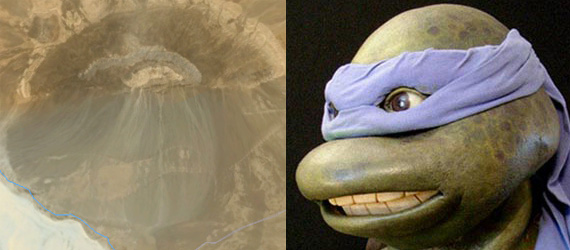
Seriously, though. Good post and good research!
/TOA
Donatello.

Seriously, though. Good post and good research!
/TOA
reply to post by The Old American
Ha!!!
That's really good.. prime example of "we see what we want to see"..
Now, if you can connect the other turtles to the rest of paintings then I'll be really impressed
I can see how you got that too.. well spotted..
Ha!!!
That's really good.. prime example of "we see what we want to see"..
Now, if you can connect the other turtles to the rest of paintings then I'll be really impressed
I can see how you got that too.. well spotted..
I don't want to shoot this down or anything but its all just not defined enough to say it looks like this or that unless i am missing something? The
eye of Horus on the crater is a nice oddity but not even close to any representation of it.
Maybe it is just me but all the examples seem to be clutching a straws to make some meaningful connection.
Maybe it is just me but all the examples seem to be clutching a straws to make some meaningful connection.
reply to post by Indigo2
I unbderstand what you're saying and that has been in my mind since I first noticed the eye.
But when i saw other stuff and eventually the map, it just became one coincidence after another and another and I had to come to the conclusion that none of it was coincidence.. It had to be by design.
It had to be painted in a way that only those with, let's say, knowledge of maps and map reading, would be able to understand the whole picture..
And this is something that bothers me.. If this was intended for and advanced culture to discover and understand, just how far advanced do they have to be? It may be that we might only be able to read 3/4s of the painting and the rest wont make any sense so we'll never get to discover everything in all that wonderful detail.
We may find that we will have to progress another 200 or even 500 years before we have a state of knowledge that matches this previous intelligence level.
I kinda hope that we have gone past the level required and will eventually find all there is and understand it all..
If I'm right that is
From what I can see, it is a wonderful story filled with loads of stuff from their culture and lives.. trying to seperate it all and categorise it is a bit hard, especially trying to present it in a way that is easy for everyone to follow.
I unbderstand what you're saying and that has been in my mind since I first noticed the eye.
But when i saw other stuff and eventually the map, it just became one coincidence after another and another and I had to come to the conclusion that none of it was coincidence.. It had to be by design.
It had to be painted in a way that only those with, let's say, knowledge of maps and map reading, would be able to understand the whole picture..
And this is something that bothers me.. If this was intended for and advanced culture to discover and understand, just how far advanced do they have to be? It may be that we might only be able to read 3/4s of the painting and the rest wont make any sense so we'll never get to discover everything in all that wonderful detail.
We may find that we will have to progress another 200 or even 500 years before we have a state of knowledge that matches this previous intelligence level.
I kinda hope that we have gone past the level required and will eventually find all there is and understand it all..
If I'm right that is
From what I can see, it is a wonderful story filled with loads of stuff from their culture and lives.. trying to seperate it all and categorise it is a bit hard, especially trying to present it in a way that is easy for everyone to follow.
new topics
-
To become president, Zelensky had to learn Ukrainian
Political Conspiracies: 54 minutes ago -
Green Grapes
General Chit Chat: 4 hours ago -
Those Great Fresh Pet Commercials
Television: 10 hours ago
top topics
-
Joe meant what he said about Hunter's pardon....
US Political Madness: 13 hours ago, 12 flags -
S.C. Jack Smith's Final Report Says Trump Leads a Major Conspiratorial Criminal Organization!.
Political Conspiracies: 12 hours ago, 11 flags -
Advice for any young Adult .
General Chit Chat: 13 hours ago, 10 flags -
Green Grapes
General Chit Chat: 4 hours ago, 5 flags -
It’s Falling…
Philosophy and Metaphysics: 16 hours ago, 4 flags -
Regent Street in #London has been evacuated due to a “bomb threat.”
Other Current Events: 14 hours ago, 3 flags -
Those Great Fresh Pet Commercials
Television: 10 hours ago, 3 flags -
To become president, Zelensky had to learn Ukrainian
Political Conspiracies: 54 minutes ago, 2 flags
active topics
-
Some sausage, some chicken, some sauce, some onions and some garlic...and some peppers!
Food and Cooking • 4 • : putnam6 -
Los Angeles brush fires latest: 2 blazes threaten structures, prompt evacuations
Mainstream News • 112 • : Degradation33 -
S.C. Jack Smith's Final Report Says Trump Leads a Major Conspiratorial Criminal Organization!.
Political Conspiracies • 42 • : WeMustCare -
House Passes Laken Riley Act
Mainstream News • 22 • : KrustyKrab -
To become president, Zelensky had to learn Ukrainian
Political Conspiracies • 0 • : Imhere -
Russia Ukraine Update Thread - part 3
World War Three • 6904 • : Imhere -
Steering the Titantic from the Drydock.
Rant • 43 • : charlest2 -
What Comes After January 20th
Mainstream News • 33 • : underpass61 -
President Carter has passed
Mainstream News • 44 • : WeMustCare -
Those stupid GRAVITE commercials
Rant • 13 • : GENERAL EYES
